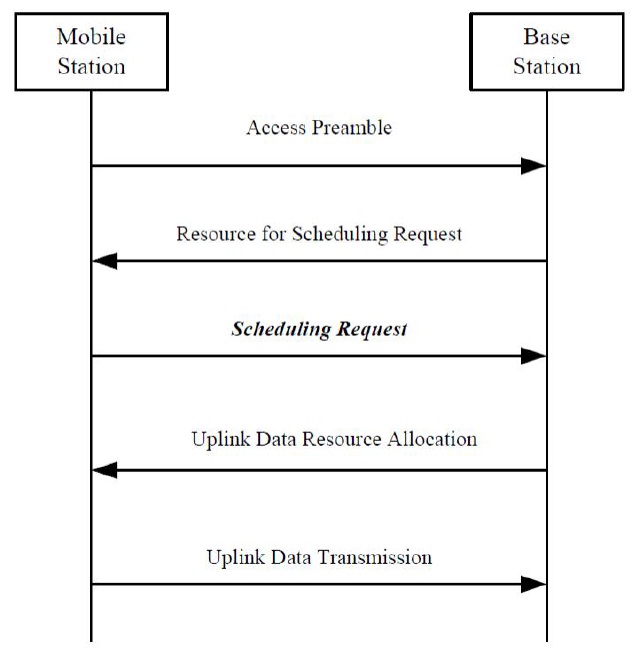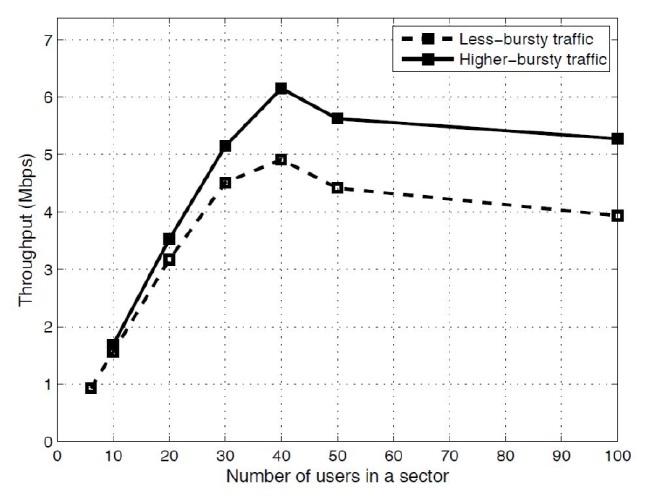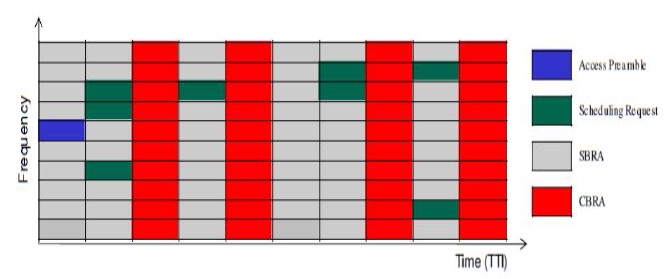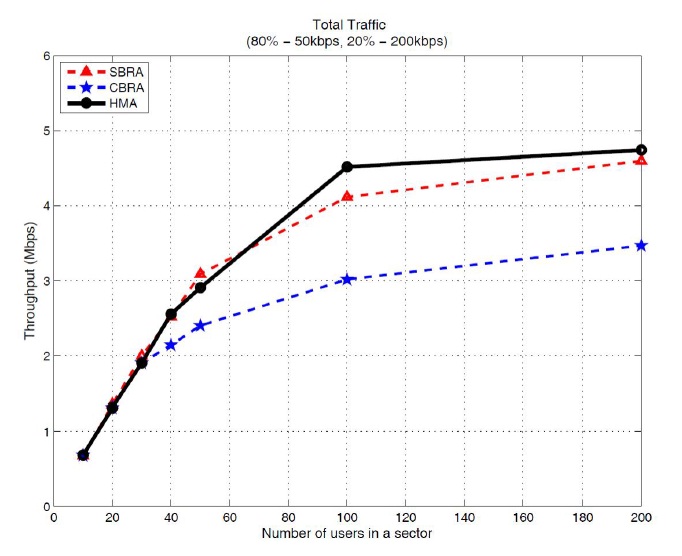



We propose a hybrid multiple access (HMA) for uplink orthogonal frequency division multiple access (OFDMA) systems, which combines two resource sharing schemes: a scheduling-based resource allocation (SBRA) scheme and a contentionbased resource allocation (CBRA) scheme. The SBRA scheme is appropriate for non-real time high data rate traffic, and, CBRA is appropriate for near-real time low/medium data rate traffic. Thus, the proposed HMA scheme supports various types of traffic. As a CBRA scheme, our proposed random frequency hopping (RFH)-OFDMA scheme was presented. Simulation results show that the proposed HMA yields the best performance among various resource allocation schemes for uplink OFDMA systems.
Next-generation wireless communication systems are expected to support various multimedia services with different quality-of-service (QoS) requirements [1-5]. They will require increasingly high data rates, extended coverage, low latency, low deployment cost, and so on. Most wireless communication systems have evolved to satisfy these requirements [6-11]. On the other hand, recently, multiple resources have been simultaneously considered for scheduling and data transmission to improve system flexibility and efficiency [3,12]. Hence, in next-generation wireless networks, multi-dimensional resource based multiplexing (downlink) and multiple access (uplink) will be important technologies. When multi-dimensional radio resources are used, the development of efficient algorithms for radio resource management (RRM) is critical from the perspective of networks because such functionalities have a significant impact on the fulfillment of QoS requirements, and on attaining higher degrees of spectral efficiency.
Multiple access (MA) protocols can be classified according to the manner in which bandwidth is allocated; fixed allocation and dynamic allocation. The main advantage of the fixed assignment schemes is that each user is guaranteed a share of the link bandwidth and transmissions generally do not interfere with one another. The disadvantage is that channel resources are dedicated to users and the unused bandwidth cannot be transferred from one user to another. Thus, while the fixed assignment protocols yield excellent throughput performance under steady, heavy traffic conditions, the performance delay can be quite poor when the traffic load is light and bursty.
The obvious solution to this problem is to design a protocol that allocates channel resources only to users with data to transmit. A typical approach to achieve this objective is to maintain a global queue of requests from users who wish to transmit. The centralized scheduler can be used for allocating/de-allocating resources at the controller (e.g., base station in cellular networks). Unfortunately, such users must be identified and this information can be only exchanged through the channel itself. Most of these schemes are attractive since they offer a reasonably minimal delay under light traffic loads and high throughput under heavy traffic loads. However, if the overhead involved in maintaining the global queue becomes large (e.g., due to long propagation delays), the performance of these schemes also degrades.
The class of contention-based protocols is useful when a very few users wish to access the channel at any given time. In this case, rather than maintaining a global queue, each ready user decides independently when to access the channel. These uncontrolled schemes are very easy to implement but pay the price in the form of wasted bandwidth due to collisions when multiple users access the channel at the same time. Such protocols usually have excellent delay performance under a low traffic load but the throughput degrades quickly under a high traffic load. Contention-based protocols do not require the identities of the ready users to be known in advance.
In practice, there exist various traffic sources in wireless communication systems and these MA techniques need to be utilized all together since each MA technique has its own benefits and drawbacks. However, to the best of our knowledge, the hybrid MA technique has not been studied rigorously. In this paper, we propose a hybrid multiple access (HMA) method for uplink orthogonal frequency division multiple access (OFDMA) systems, which combines two resource sharing schemes: a scheduling-based resource allocation (SBRA) scheme and a contention-based resource allocation (CBRA) scheme.
II. CONVENTIONAL UPLINK SCHEDULING AND TRAFFIC CHARACTERISTICS
Fig. 1 shows the typical procedure of the uplink scheduling in cellular networks. First of all, a mobile station (MS) which has a packet to be transmitted sends the access preamble to the corresponding base station (BS). When the BS receives this preamble, it transmits the resource allocation information for scheduling requests of the MS. Using this information, the MS transmits a
In the conventional uplink scheduling schemes, the signaling overhead dramatically increases when the number of MSs in a cell increases because it requires exchange of four signaling messages including one access preamble prior to data transmission, as shown in Fig. 1. In practice, when the size of the data packet is small, the signaling overhead is not negligible. Traffic sources can be characterized by two stochastic processes: 1) the message generation process (represents the packet arrival characteristics), and 2) the message length distribution process (represents the packet size characteristics).
Using these stochastic processes, we can categorize the traffic sources into two types. We assume that these two processes follow a Poisson distribution which is a typical model in traffic characterization [13,14]. The first type of traffic has short packet inter-arrival time and small packet size. We call this type of traffic low-bursty traffic. In the less bursty traffic, packets frequently arrive at the user traffic queue. Voice-over-internet protocol (VoIP) and gaming traffic belong to this type of traffic. The second type of traffic has long packet inter-arrival time and large packet size. We call it higher-bursty traffic. In the higher-bursty traffic, large packets arrive at the user traffic queue infrequently. File transfer protocol (FTP) and hypertext transport protocol (HTTP) traffic are typical examples of higher-bursty traffic.
[Table 1.] System-level simulator parameters
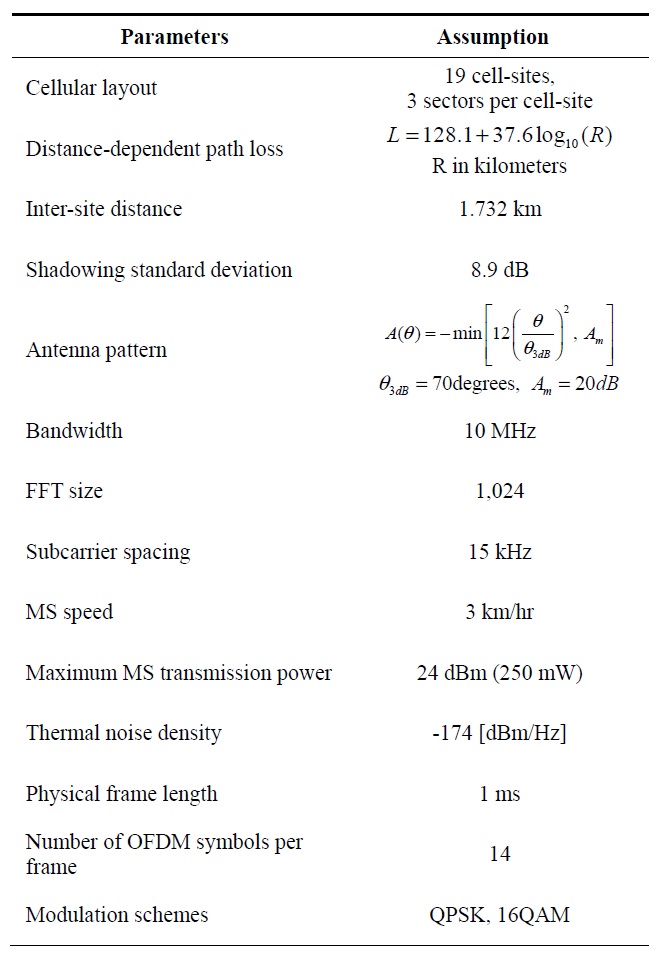
System-level simulator parameters
As we noted before, in the less-bursty traffic, the signaling overhead becomes significant because the relative ratio of the signaling overhead to the data packet size is large in this traffic. We verify the effect of traffic characteristics on the uplink scheduling performance in wireless communication systems through system-level simulations. Table 1 summarizes the parameters of the system-level simulator used in this chapter. We utilize the typical system parameters of 3rd generation partnership project (3GPP)-long term evolution (LTE) specifications [15].
Fig. 2 compares the uplink throughput of the SBRA with different traffic characteristics. The uplink scheduling follows the procedure in Fig. 1. We assume that the two types of traffic have the same input load for fair comparison, which indicates that the input rate of each traffic is the same. In the higher-bursty traffic, the mean packet inter-arrival time is set to 0.1 second and the mean packet size is set to 20,000 bits. Hence, the mean data rate of the traffic is equal to 200 kbps. On the other hand, in the less-bursty traffic, the mean packet inter-arrival time is set to 0.01 second and the mean packet size is set to 2,000 bits. The mean data rate of the traffic is also 200 kbps, which is equal to the case of higher-bursty traffic. As we noted before, the stochastic processes of the packet inter-arrival time and the packet size are assumed to be Poisson distributed. Both types of traffic are served with the same scheduling policy (round-robin, RR). Both throughput results of the two types of traffic increase when a small number of MSs exist in a sector and then decrease when the number of MSs becomes larger than 40.
This is due to the fact that the signaling overhead from the scheduling procedure becomes larger as the number of users increases. Note that the throughput of the higherbursty traffic is larger than that of the less-bursty traffic since the number of the packets in less-bursty traffic for the same input load and the less-bursty traffic requires more signaling procedures for each packet. This phenomenon becomes severe if the packet size of traffic becomes smaller. Therefore, the SBRA scheme is more appropriate for the higher-bursty traffic.
III. PROPOSED HYBRID MULTIPLE ACCESS PROTOCOL
We propose a random frequency hopping - orthogonal frequency division multiple access (RFH-OFDMA) protocol, which allows multiple MSs to use the same subcarrier at the same time according to their frequency hopping pattern (HP). It can be regarded as a CBRA scheme since, in the proposed RFH-OFDMA, each MS transmits its data packet according to its HP once a packet arrives at the traffic queue. In this section, we propose a HMA protocol that combines the conventional two resource allocation schemes: SBRA and CBRA. We utilize SBRA for the higher-bursty traffic and CBRA for the less-bursty traffic. Fig. 3 shows the block diagram of the proposed HMA scheme. The BS can determine both the type of traffic that is assigned to a specific resource allocation scheme and the amount of resources which is assigned to the SBRA or the CBRA scheme. If the amount of the higher-bursty traffic in a sector increases, then the BS increases the portion of the resources that are assigned to the SBRA scheme. In the proposed HMA scheme, the total resources are divided into two parts and the boundary of the two parts can vary according to the traffic pattern of all of the MSs.
Fig. 4 illustrates an example of the frame structure for the proposed HMA scheme. In this example, the total resources are divided into two parts in the time-domain resource (TTI). In the third, fifth, eighth, and tenth TTIs, all of the MSs operate with the CBRA scheme and, in the remaining TTIs, all of the MSs operate with the conventional SBRA scheme. Through this simple frame structure, we can combine these two resource allocation schemes efficiently.
In this section, we compare the throughput performance of various resource allocation schemes: the conventional CBRA, the conventional SBRA, and the proposed HMA that combines these two resource allocation schemes. We assume that each MS has either higher-bursty traffic or lessbursty traffic. In the higher-bursty traffic, the mean packet inter-arrival time and the mean packet size is the same as that set in section II. However, in the less-bursty traffic, the mean packet inter-arrival time is set to 0.01 second and the mean packet size is set to 500 bits in this section. The mean data rate of the traffic is also 50 kbps, which is much smaller than the case of higher-bursty traffic because this assumption is more reasonable. In practice, the less-bursty traffic requires a lower data rate than the higher-bursty traffic. We assume that 80% of the total MSs in a sector requires less-bursty traffic and 20% of the MSs requires higher-bursty traffic and, thus, the total input load of each type of traffic is the same. We allocate half of the TTIs to the CBRA scheme according to the total input load of each type of traffic.
Fig. 5 illustrates the total sector throughput of various resource allocation schemes including the proposed HMA scheme for varying the number of MSs per sector. When the number of MSs is small, all schemes yield similar throughput performance, but the performance difference becomes large as the number of MSs in a sector increases. The CBRA yields the worst performance in cases in which the number of MSs is large because many symbols experience HP collisions. In this case, unnecessary packet retransmissions are required. If the number of MSs is equal to 100, the throughput increase in the SBRA scheme becomes small since the signaling overhead becomes significant. The proposed HMA scheme balances the signaling overhead and HP collision effect by controlling the amount of the allocated resources to each resource allocation scheme. Therefore, the proposed uplink HMA scheme can be very efficient in a mixed traffic environment.
In this paper, we proposed a hybrid multiple access protocol that combines the conventional resource allocation schemes: SBRA and CBRA. We utilize the RFH-OFDMA proposed in [16] for the contention-based resource allocation scheme. Both SBRA and CBRA have benefits and drawbacks. These characteristics can be combined according to traffic characteristics. Higherbursty traffic is more appropriately supported by SBRA and less-bursty traffic is more appropriately supported by CBRA due to the signaling overhead of uplink scheduling procedures. Simulation results show the proposed HMA yields the best throughput performance in the mixed traffic environment of uplink cellular systems. Furthermore, the proposed HMA is regarded as a more generalized version of conventional SBRA and CBRA from the perspective that the boundary of the resources allocated to each resource allocation scheme can be controlled more flexibly.
